"Look At Me Now" And Five Other Good Rap Songs From This Week
The venerable Busta Rhymes shows us what people mean when they talk about an MC “blacking out” on a track. He rhymes so fast, enunciates so clearly, without pausing to take a breath, you’d think he’d lose consciousness. In so doing, he steals this song — with it’s huge and spacious beat, which was produced by club music maestro Diplo and sounds like it will explode dance floors like the Yin Tang Twins “Wait (The Whisper Song)” did six years ago — from proprietor Chris Brown and fellow guest star Lil Wayne both.
Here are a bunch of other good rap songs that came out this week.
Project Pat is the older brother of Three 6 Mafia’s Juicy J, and an important part of the storied Memphis group’s greater collective. He voiced the hook on Three 6’s year 2000 hit “Sippin’ On Some Sizzurp,” and had a national hit of his own with “Chickenhead,” from the wonderfully-titled 2001 album, Mista Don’t Play, Everythangs Workin. For connoisseurs of the dirtiest of Dirty South rap, it gets no better than Project Pat. Hearing him over this tantalizing beat from the young super producer Lex Lugar is a joy, and the verse from lady rapper Tatalicious is some good give-as-good-as-she-gets stuff, but be forewarned, this song is very, very dirty. The video makes great use of terrible lighting. It’s like an amateur porn film, I guess. (But don’t worry, no actual nudity occurs.) Also, if you don’t want to use your head in the way Pat suggests, you can always put it into his wine glass.
Next is the Bronx’s Fat Joe, rapping with Harlem’s Vado over an AWESOME AWESOME track produced by Washington, DC’s Mark Henry. This is my favorite song of the week.
Raekwon the Chef released a new album this week, Shaolin Vs. Wu-Tang (a confusing title, as I thought Wu-Tang were from Shaolin, but I bet it makes sense if you’ve watched as many kung-fu movies as Raekwon has.) It sounds great to me so far, full of vintage, mid-90s-era Wu-sonics and verbal swordplay (as Rae and co. might put it.) Especially “Mollases,” featuring Rick Ross — who, I must admit, though I’ve never been a fan, is sounding better and better with his raps — and this song, with GZA and Killa Priest. Oh, Raekwon compares himself to Hitler in his verse. So, there you go.
North Carolinian producer 9th Wonder slices up a famous Flavor Fav clip and pastes it into a dreamy backdrop for Lil B’s latest stream of stream-of-consciousness rap. Where it sounds just right.
Lastly, I was very excited to hear the news that Big Boi was getting back together with his protege Killer Mike (a.k.a., “Mike Bigga”) and fellow Atlanta rapper Pill to make a full-length album as a supergroup trio. From the sound of this remix that Big Boi just did for “Ready Set Go,” the excellent song that Chicago’s No I.D. produced for Mike and T.I. last year, very good things could be to come.
The World's Most Expensive News Backend
Hey, how much did your content management system cost? Was it… ONE MILLION DOLLARS? Astounding, but hey, it’ll be open source. So it’s an incredibly expensive socialist CMS I guess.
Eat, Pray, Judge: Pancakes With The Episcopalians
by Dan Packel

With a rarely seen uncle who’s been involved in Scientology for decades, I’m a sucker for stories about the “church.” Thanks to the New Yorker, I had an informative month of February. But I was most interested to discover that their Celebrity Centre is an excellent, undiscovered destination for a high-quality, cheap lunch when in Hollywood. As a committed eater, I was curious: Do other religions offer equally worthy opportunities for subsidized dining?
A recent dinner conversation with some Episcopalian friends provided an opportunity to begin an investigation. “Our church is doing a pancake supper for Shrove Tuesday,” said Emily, over a meal of eggplant, polenta and fresh-baked foccacia. “You should come along.”
I had to do a little research first. It turned out that Shrove Tuesday matched up with Mardi Gras; this was the day prior to Ash Wednesday, a time for celebration before beginning the deprivations of Lent. I figured I didn’t need to repent to enjoy a big plate of pancakes.
When I arrived at St. Mark’s Church for the supper, there was some confusion about when pancakes would actually be served. On Emily’s direction, I’d shown at 6 pm, while other pieces of information circulating noted that the event started at 6:30, or even 7.
No problem. After a warm greeting from the small kitchen, where a handful of parishioners appeared hard at work preparing the meal, I was directed to a table stocked with libations. Sadly, a leader of the church prominent in the local beer scene had passed away recently. But there was a significant cache of local craft beer left over from his funeral service. I opened a bottled of Stoudt’s Pale Ale (crisp yet hearty) and started making conversation.
The church members were a welcoming lot — clearly happy to share a meal with guests. I was expecting to make a token contribution for the food, but couldn’t find the opportunity to do so. Austerity didn’t seem to be on the agenda either. Learning that I’d just started working in the office of a local restaurant known for its wine and beer program, Rector Sean Mullen told me: “I don’t care if you’re an Episcopalian, a Presbyterian, a Catholic or a Jew… If you’re working on beverages there, I want you to become a member of this church.”
Sooner than expected, owing to the confusion over time, people began gravitating towards the food table. I followed them over. Some members of the kitchen contingent were now serving from behind the table. I piled my paper plate high with pancakes, strawberry compote, a banana nut topping, crisp bacon and juicy sausage links. The scrambled eggs came out from the kitchen later.
Then it was over to the long communal table, decorated with a swatch of glitter down the middle, looking as if a pixie had just run a 50-yard dash down its center. I dug into my meal, while following along with the spirited discussions surrounding me — ranging from liberal-minded debates on religious doctrine to tales of college road trips in the days before many Ivy League schools went co-ed.
While performing my due diligence, I learned there’s a rich tradition of pre-Lenten eating. German Americans traditionally consume fastnacht, or fried potato dough served with dark corn syrup, while Polish Americans go for pączki, fried dough balls, akin to doughnuts. In the British Isles, and the church communities that have roots there, the food of choice is pancakes.
As an agnostic from a family with a complicated religious heritage, churches are unfamiliar locales. But breakfast for dinner, when even just adequately prepared, provides undeniable comfort. Pancakes evidently emerged as a Shove Tuesday staple because they allowed members of the community to use up rich foods like milk, eggs and butter before the fasting period. These imperatives were certainly met in the moist, fluffy cakes, only slightly cooled during the trip from kitchen to table.
I can recommend these Episcopalians for a variety of reasons. The food was solid, to be sure. But the spirit of inclusiveness was even stronger. We were part of a diverse crowd of straights, gays, blacks, whites, Asians — all along the same table. There was even room for the disheveled-looking dude in the leather jacket down at the end of the table (though he wasn’t doing much conversing, just eating). I liked the free beer and wine, too.
But these people weren’t all saints. When, serving duty complete, Emily finally sat down with her own plate, she shared a gripe she held with one of her co-religionists.
“No… not that sausage,” a diner had apparently complained. “Can I have that one?” she said, pointing at what presumably was a more precisely cooked specimen.
Emily had managed to keep her mouth shut until she was done and seated with friends. “Honey, it’s a free sausage.”
I hope they know I was grateful for mine. But a final note for the Episcopalians — there’s rarely an excuse for Aunt Jemima’s in the plastic bottle. Next time I’ll make my own contribution: real maple syrup.
Dan Packel writes about food (and more!) from his home in Philadelphia. You can also follow him here.
Photo by D’Arcy Norman.
'Times' Rape Story Gets Sternest Language Available from a Public Editor
Just FYI: Gang Rape Story Lacked Balance is about as strong a condemnation as you’ll get from the Times public editor. I mean, it’s not like he’s going to print “That Story Was a F’ing Shit Show, Am I Right?” It’s not his way; they are exceedingly old world and genteel. Also, interesting that no editor or reporter interviews took place. (As of yet! That we know!)
Wisconsequences: What Happened This Week and What's Next (Up First: the Voter ID Bill)
by Abe Sauer
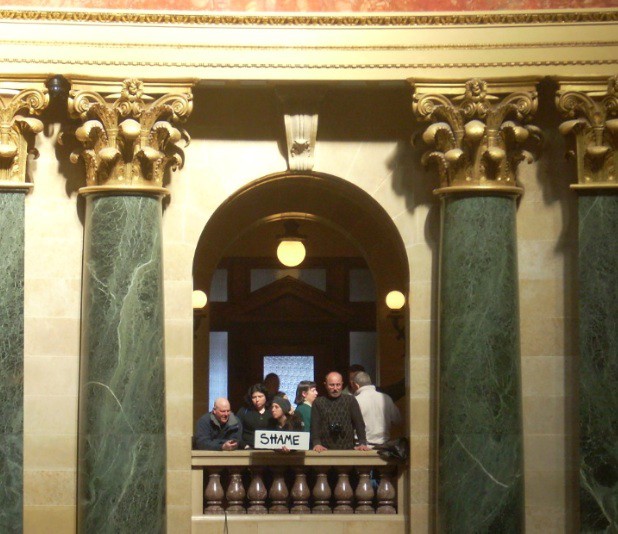
On Wednesday night, Wisconsin’s state senate amended Governor Scott Walker’s budget bill and speedily voted it through, using a loophole that made a quorum unnecessary. Just 24 hours later, after a couple hours of “discussions” that turned the assembly chamber into a straw man carnival and included a motion to remove the majority speaker on the grounds of “impaired judgment,” the Assembly voted to pass the bill. Walker will sign off, after some legal questions are answered. There will be lawsuits, and consequences.
“Elections have consequences” was the hammer used to drive the spike that has now severed union employees from collective bargaining. So that is now the call of Democrats and pro-union activists, who’ve committed to a large-scale, state-wide recall effort to turn those who voted for the bill into “consequences.” But after the passage of the budget “repair” bill, which vastly reduces the financial power of unions to support Democratic pro-union candidates, Republicans have a whole new trick up their sleeve to make sure that future elections have no such consequences.
“Ultimately, I voted my conscience which I feel reflects the core beliefs of the majority of voters who sent me here to represent them,” said Senator Dale Schultz on Wednesday night. A moderate Republican from the “swing” county of Sauk, Schultz’s lone no-vote was joined by four other Republicans in the assembly.
In the last few weeks as Walker has claimed that he’s giving local leaders the tools they need, more and more of these leaders have come forward to declare that they did not ask for a berth as wide as Walker means to provide. Miles Turner, executive director of the Wisconsin Association of School District Administrators, told the Isthmus: “We’ve sought significant modifications in bargaining laws, but we’ve never sought to eliminate collective bargaining rights.” Turner reiterated that his organization, which represents nearly all 424 Wisconsin school districts, did not support eliminating collective bargaining.
The Isthmus also spoke with Dan Thompson, executive director of the League of Wisconsin Municipalities, representative of nearly 600 of the state’s towns, who said, “The governor gave us a great deal more flexibility than we asked for.” Thompson pointed out that the bill’s limitation to cost-of-living increases will cripple abilities to compete with the private sector, the exact kind of commutative equality Walker claims his bill promotes.
So, to be perfectly clear, despite how Walker’s cuts and union dissolving measures are pitched as being undertaken because Wisconsin had “no choice,” it was all about choice. Wisconsin looked at its budget, and it chose to make massive cuts to education. Instead of making across the board, equilateral cuts, including minor tax increases and union concessions, Walker chose to balance his entire budget on the back of education. That’s it. It was a conscious decision. They should own it.
On Wednesday and Thursday of this week, Republicans owned it. They owned the hell out of it.
Kevin Gibbons, co-head of the Teaching Assistants’ Association which has ceaselessly worked to organize and mobilize protesters over the last three weeks, said that in the run up to the vote, he believes the Republican leaders manipulated the police to create the conditions under which something unpleasant would happen, creating a PR win against the demonstrators. “[Wednesday] night they rushed that vote at the exact moment the capitol was to be closing without telling the police,” he said. He thinks they had to know it would cause an explosion of rage that the police didn’t have the numbers in place to deal with. Gibbons said that usually super-cool Capitol Police Chief Tubbs had become visible enraged Wednesday night by the position into which he had been forced. Madison radio station WORT reported that the Wisconsin Law Enforcement Association was seeking legal protection from possible illegal use of State Patrol by Republicans during the crisis.
If true, it appeared to have worked Thursday morning, as the Capitol remained locked well past the 8 a.m. opening time. As rumors that the assembly was aiming to vote on the bill with the doors locked (a violation of the state constitution), thousands and thousands of protesters arrived. Many banged on the doors, and hard. With little information about what was going on inside beyond “security concurs,” increasingly upset demonstrators grew angrier. That the doors were even locked to all press only increased suspicions. Adding to the information vacuum, the police outside had no information beyond that they were to let “nobody in.”
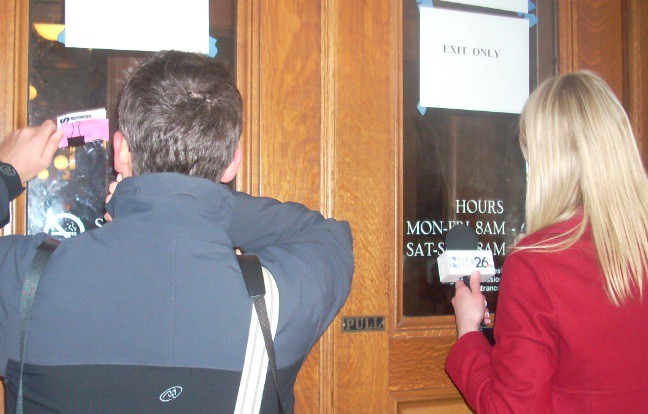
At about 11 a.m., the time the assembly had set to convene the special session, hundreds of the high school students I had seen a half an hour earlier marching up East Washington Avenue joined the growing number of “rabid leftists” at the dome on the hill. They convened at the West Washington doors, which also happened to be the (supposed) designated press entrance.

In a display of “fair and balanced” spite so shockingly naked and grotesque that it must be mentioned, the cameraman for WLUK Fox 11, northwest Wisconsin’s Fox affiliate, mocked the peaceful and happy teens. “Do you even understand the issues?!” he yelled at them. I took a picture of him, because, even forgetting that he works for an ostensible news organization, what kind of soulless dirtbag criticizes teenagers for being engaged in politics, much less politics that directly affect their lives?

Press was finally allowed in and rushed to the assembly chamber.
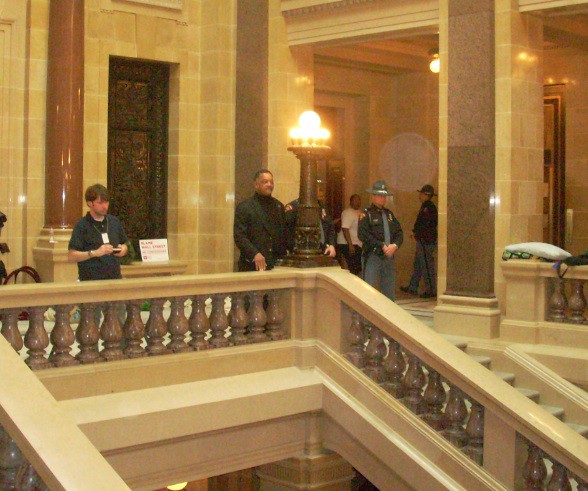
Democrats attempted to stall the vote, repeatedly revisiting questionable tactics of the Republican leadership. Minority Leader Peter Barca introduced a motion to remove Assembly Speaker Fitzgerald from his position, citing his breaking of open meetings law and “impaired judgement.” Speaker Pro Tem Bill Kramer sipped from a can of Mountain Dew and chuckled.
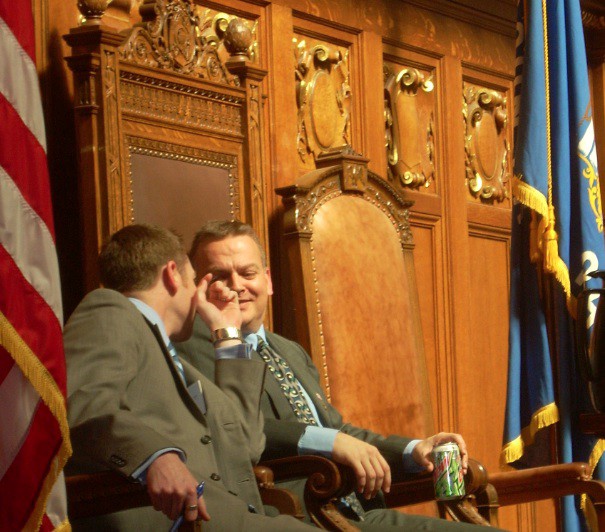
What followed was the kind of non-partisan rhetorical display that obliterates a normal person’s opinion that somebody must somehow be extremely intelligent to be able to put together a campaign and win an elected seat at a level as high as the state capitol.
Democratic Rep. Cory Mason argued that “Martin Luther King was assassinated fighting for the rights you’re trying to take away.” Rep. Barca held a lit lighter aloft and, on the way to making a point of some kind, declared there were no written rules that he could not burn down the building.
Republican Rep. Jeff Fitzgerald (Scott Fitzgerald’s brother) then read a death threat addressed to Republicans from somebody quite clearly unrepresentative of three weeks of tens of thousands of peaceful protesters. Then he said that people were sick of politicians on both sides saying one thing and then coming to Madison and doing another, ignoring that, for instance, Ed Brooks (R-50) did exactly that to the teachers union that endorsed him. Rep. Robin Vos said that “voters made a choice for a new direction,” the three-dollar version of “elections have consequences,” and then defended the bill the Republicans had introduced as being the same thing Obama had done on the federal level.
It’s notable that none of the display in the assembly chamber could hold a candle (or, in Barca’s case, a lighter) to Governor Walker’s morning press conference. In it, the governor, praising the Senate’s passage of the bill the night before, warned against allowing “influences from outside of Wisconsin to come in our state.” That came after Megan Sampson, the teacher he named in his Thursday morning Wall Street Journal op-ed as a beneficiary of his policies, turned out to have written a week earlier on her blog “So, please, for those of you reading this, please know that I am NOT anti-union, and I do not appreciate the way my story is used to pin blame or negativity on unions.”
Democrats slipped Reverend Jesse Jackson into a speaking opportunity in the assembly by way of a prayer. What were Republicans going to do, not allow a prayer? But Jackson’s presence itself ended up being far more partisan than his words.
Whatever one’s opinion of Jesse Jackson may be, his capital-P Presence is undeniable. Like watching a History Channel recreation of an iconic moment, it transports one to, if not the actual moment, then to a place where one could at least begin to imagine the significance of that moment.
Jackson talked with me about how there was no draft for students now and so today’s youth don’t pay for our wars in blood, but in money, in the form of debt. Then I lost him on a tangent about forgiving student loan debt as an economic stimulus.
But then: “What would you say to young people who’ve taken part in all of this in Wisconsin… those who see all the effort and yet none of it seemed to matter?”
“Transformative struggles require persistence and long distance runners,” he said. “We need long distance runners.”
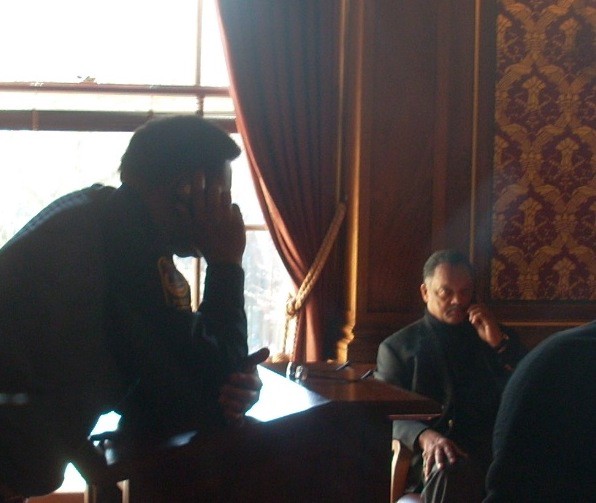
Even before the vote Thursday afternoon, the TAA’s Gibbons conceded the bill would pass, saying it is no longer about killing the bill, but about a recall effort. “The key is to keep this momentum and interest and engagement up and funnel it into recall efforts,” he said. “We can’t let this energy go.” Gibbons added that the methods with which the Republicans finally did pass the bill probably helped increase engagement more than any TAA email campaign.
He’s right. After the capitol was “reclaimed” by the state and went back to regular hours, protesters no longer stayed the night. The vibe of the movement changed; the energy certainly dropped. Protesters were still showing up every day and passions were high, but as with anything else that comes to have regular hours, monotony sets in and passion wanes.
But with the two rushed votes in a questionable atmosphere of openness — a capitol closed against court order and wide reports of Democratic legislators who themselves had trouble entering the building (one reportedly had to break in though a window) — outrage has rebounded.
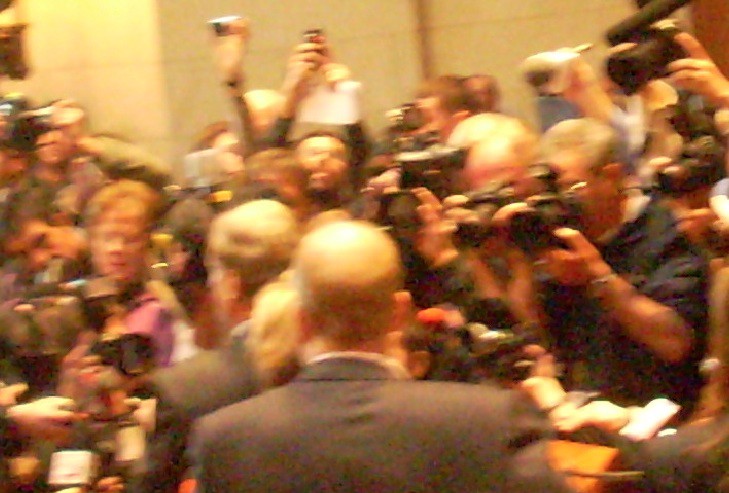
“See you in the courts!” came the scream from the gallery as the Republicans skedaddled out the back door of the assembly chamber. The vote happened so fast hardly anyone even knew what had occurred. (Staffers in the antechamber asked one another, “What the hell just happened? Did they vote? Was there a vote?”)
It looks like the anonymous man in the gallery was right. Outgoing Dan County Executive Kathleen Falk was celebrated when she announced that she had “directed our county attorneys to take legal action today to ensure the laws and rules followed by public policymakers in this state for generations are followed.”
One Republican who probably doesn’t appreciate his party’s recent methodologies is conservative Supreme Court Judge David Prosser, who faces a reelection battle on April 5th. It’s possible that even the Club for Growth’s heavily lopsided spending in favor of Prosser, which has been as dirty as dirty can be , will be enough to save him.
Prosser may be the first reverse swing “consequence” of an election that is just weeks away. In addition to a supreme court judge, Wisconsinites will pick school board members, all positions that may prove in the coming year, as lawsuits are elevated and districts weight their options of how to use Walker’s “tools,” even more important than anyone in the legislature or Governor’s mansion. All the show of solidarity warm fuzzies aren’t worth much if the same energy doesn’t carry to the polls.
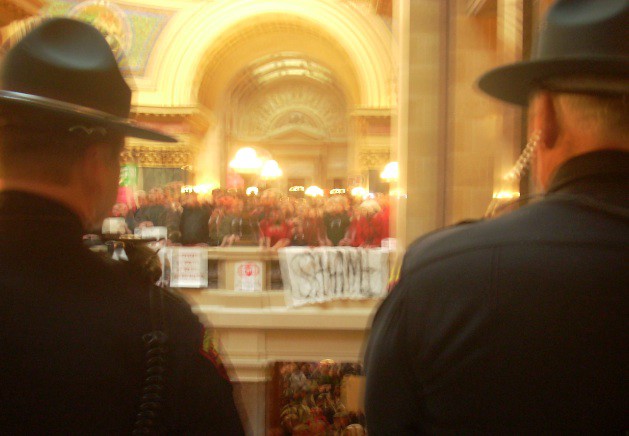
One way some of the Republicans may be able to salvage their political careers in the state is through another insidious bit of legislation, a voter ID bill. This will be one of the first pieces of legislation the Republican-run legislature picks up in the April session after the return of the 14 Democratic senators, who will still be powerless to stop them.
The Republican leadership is already selling its Voter ID bill as a “compromise.” The compromise was that the bill now adds more forms of acceptable identification: in addition to driver’s licenses, the list now including tribal IDs, naturalization papers and passports. Yes, the amended bill now includes passports.
Wisconsin Republicans have had a hard-on for a voter ID bill for years. Democratic Governor Jim Doyle vetoed all of them in recent years. There will be no such veto this time.
Wisconsin Senator Mary Lazich (R-New Berlin) said of the amended bill, “Ensuring integrity of elections is of utmost importance in our democracy. Requiring voters to show photo identification is a reasonable step and one that is constitutional.”
A year ago, when Wisconsin still had a Democratic governor, the Wall Street Journal’s John Fund made a huge case about voter fraud in Wisconsin. His criticisms were that a bill encouraging voter turnout “was suddenly introduced and rushed forward with only abbreviated hearings.” Fund has been a huge defender of recent Republican actions in Wisconsin.
At the time, Fund cited all kinds of bogus data that painted a picture of a state where voting seemed essentially little different from, say, Afghanistan. But Republican Attorney General J.B. Van Hollen has taken action on 20 cases of voter fraud in millions of votes cast since 2008. The New York Times notes that prosecutors “have lost almost twice as many cases as they won” and that many of these chargers were against “felons seemingly unaware that they were barred from voting.”
The Brennan Center for Justice at NYU School of Law points out that in the 2004 election (the same one Fund went all apoplectic over), Wisconsin voter fraud allegations “yielded only 7 substantiated cases” amounting to “0.0002% within the state as a whole.”
And none of those cases could even have been prevented with a Voter ID law anyway.
What makes those tiny handful of voter fraud cases even more significant is that Wisconsin as a whole has one of the highest voter turnout rates in the nation (70.9 percent in 2008) and the state consistently has one of the three highest voter turnout rates for those under 30, many of them students. Guess which party for which they overwhelmingly vote? (Hint: Not the party that has introduced a voter ID bill, especially one that does not recognize student IDs).
Still, if the Voter ID bill passes, and it will, it will most disenfranchise the elderly, low income and minority voters. Both parties have voters within this group, so the tragic thing is that Republicans are willing to disenfranchise their own voters, as long as they get more of the other guys’ then their own. Democracy!

Will the energy from the union-busting “war on teachers” cross over to less sexy, more administrative war on enfranchisement? Maybe. For now, political activism on both sides remains high in Wisconsin and it reams overwhelmingly peaceful and civil, despite lies to the contrary. Satisfying every news outlet with an unused Wisconsin joke, the state farmer’s union will be rallying at the capitol Saturday…. with a “tractorcade.”
It’s going to be a long five months in Wisconsin until the first Packers preseason game.
Abe Sauer can be reached at abesauer at gmail dot com.
'Red Riding Hood' and the Gripping Jaws of Sexless Teens

Teenagers aren’t having much sex these days. And why should they? If it’s not the AIDS resurgence or public displays of adolescent pregnancy, it’s HPV, or syphilis (yes, syphilis) or any other number of other pestilences that rot your organs and turn your genitals to corrugated mush.
So does all this adolescent celibacy mean that today’s teens are less horny than their free-love Baby Boomer predecessors, or the angst-ridden millennials, or any other group of teens in history? Not a chance. If there’s one universal of the human condition, it’s hormones: Our biochemistry is primed to make us breed, and that means endless streams of panting, sweaty youngsters entering the “mate and procreate” phase.
Our culture, meanwhile, tries to Clorox all this horniness into a sanitized, sweat-free version of gentility. Which results in all sorts of hilarious side effects, like the hardcore porn industry and the abstinence movement. Movies are the perfect mirror to reflect this cultural peccadillo back at us — they digest our collective fears and anxieties and embarrassments about sex into a thick primordial soup, and project them back in Dolby Digital. And never have movies been as reflective of the “teens want to get it the hell on but can’t” trend as now.
Into this repressed hormonal petri dish skips Red Riding Hood (opening today wherever teenagers are found). Billed as a “modern retelling of the classic tale,” this is a movie that drags all the exhausted clichés out of their tombs, dresses them up in bodices and Disney-fied tunics, and showers them with a torrent of phoned-in acting and ear-stabbing dialogue. All in the name of appealing to horny teens.
Yes, this movie is face-clawingly terrible — but it serves a purpose. Call it an experiment in filling the gaping hole before the final Twilight film emerges. Since the “new Twilight” has yet to appear from the heaving bodice of another Mormon housewife, what if we turn to classic fairy tales? The original intent of stories like “Red Riding Hood” was to scare children (read: girls) into avoiding strangers (read: men with ready and willing phalluses). What storyline could be more applicable today? Sex was scary as hell then — pregnancy meant ostracism, not to mention likely death in childbirth — and it’s scary now.
This great film-making experiment is overseen, fittingly, by Twilight director Catherine Hardwicke who, for all her vampire-related mockability, truly gets teens (have you seen Thirteen? If not, refrain from judgment). Her films understand a fundamental truth about humans trapped in the binds of puberty: They wanna bang any and everything, and if they can’t, they act out in some other way. Which, in movie-land, usually means some level of blood-spurting gore.
And gore we get. The production and execution of RRH is shoddy on just about every level — $100 says even the sweeping woodland shots during the credits came straight from unused Twilight footage — but the gore is singularly impressive. No actor (yes, not even Gary Oldman, whose presence in this film is a Book of Eli-level mystery) escapes some amount of carnage. There are decapitations, deaths by torture, hacked-off limbs, slashed faces, you name it, all packed into a supposed teen romance. And the violence, quite honestly, makes sense — you’ve shut a pack of teens away in an anachronistic village located somewhere between the Alps and Portland, and forbade them from ever getting it on. What did you think was gonna happen?
Still, as goopy and plodding as the Twilight films are, at least they stay in a realm where sexual repression doesn’t translate into heartlessness. RRH winds up in a pretty nasty place, with a Kilimanjaro-high body count (predominantly made up of innocents, including a mentally disabled boy) and a heroine (Amanda Seyfried) that is totally fine with (big fat spoiler alert — though honestly it’s like spoiling the fact that the yogurt you’re about to eat is 8 months old) killing her father and abandoning her bereaved mother in order to hang with her boyfriend when the moon isn’t full. Meanwhile, her sugar-sweet but spurned fiancé rides off into the wilderness to hunt down potential witches and werewolves in the name of religion (which, actually, has plenty of precedent in history).
Yeah sure, it’s asking for all kinds of trouble to make teens ignore their sexual urges, we know. But does doing so really give them leave to become sociopathic murderers? If those are the only options, I’ll take the Generation of HPV.
Melissa Lafsky is glad to be an adult.
'Local Hero,' A Movie You Most Definitely Must Watch
Here are some thoughts on Bill Forsyth’s Local Hero, which just happens to be my favorite film of all time. If you’ve never seen it, I would encourage you to send this link to yourself and save it for when you’ve finally watched the movie, which you should ABSOLUTELY DO AS SOON AS IT IS POSSIBLE FOR YOU. If you have seen it, you’re cleared to click: the post does a really good job of explaining why the movie is so magical.
Last Chance: The Mysteries of San Francisco's Creepy Jejune Institute

There was a slight chance we were being indoctrinated into a cult.
The night before, during a tough trivia night at the Pig and Whistle, my friend Michelle had scribbled a name and address on a cocktail napkin. “Go to 580 California Street, head up to the 16th floor and ask for the Jejune Institute.”1
“What is it?” I asked.
“I can’t tell you anything but that. Trust me, you’ll like it.” She saw me wavering. “It’ll take fifteen minutes. If you want to stop after that, you don’t have to do anything else.” And so with a few hours to kill on a rainy Saturday, my girlfriend and I went.
Which is how we found ourselves in this small office in a high-rise overlooking San Francisco’s Financial District. One wall was covered with framed photos, plaques, maps and artwork. Obscure scientific journals and odd trinkets sat on the shelves. An older man who looked extraordinarily like Terence Stamp in The Limey, minus the insane Rottweiler look, addressed us from the television. Broadcasting from a secret remote location, he explained the Institute’s role in “socio-engineering” and how various devices like telepathy and the bending of the time-space continuum will help mankind. (Think DHARMA from Lost.2) He told us to turn to our right, reach into the table drawer, and sign the consent form we’d find there.
“Do not read the initiation form,” warned the man. “I repeat: Do not read the initiation. If you do read the initiation, then do not tell anyone what it says. And do not follow the instructions.”
“What the fuck are we doing?” asked my girlfriend.
Following the instructions on that form, was what we were doing.
MASSIVELY IMPORTANT SPOILER WARNING: This is where, if you’re into puzzles, games, cults, scavenger hunts, multi-media entities or anything reminiscent — and you live or are vacationing in the greater San Francisco area in the next month (that is, before April 10th!) — you should follow the advice of my friend Michelle and just go without asking any more questions. Reading the rest of this will, ultimately, ruin it.

The directions that the man had so sternly told us to ignore led us on a wild afternoon: ducking past security guards, prowling down alleys, pushing aside metal lock boxes looking for codes, locating hidden bricks on ancient churches, peering over the balconies of private businesses and cracking passwords to listen to secret voicemails.
It was a game, but it was something more than that, too. It was a game of Nonchalance. Part public-art installation, part scavenger hunt, part multimedia experiment, part narrative story — yet even taken together, these terms don’t describe the project fully.
After my experience playing the game, I spent a few weeks obsessing about it before contacting Jeff Hull, the project’s creator. “What’s your take on this?” he asked. “Magazines have had a tough time trying to get a handle on what this is.”
A few inches north of six feet, Hull has a shaved head and soft melodic voice. He began his foray into multimedia projects a decade ago with the group Oaklandish, an artist-collective that specializes in outdoor film screenings, public art exhibitions and urban capture-the-flag games. “I had always been theorizing about narrative across media in an immersive way. In 2008, the opportunities presented themselves to produce this.”
The question is, just what is ‘this’ anyway?
Hull initially conceived of creating a simple multimedia art project. “There was this trail by my house I’d take my dog for a walk. The idea was [that participants] would gather there, tune into a radio broadcast that would walk them up the river and tell this story along the way. The experience would take a half hour total.” But some projects have a life of their own. “The universe just expanded. It became so much deeper than we initially conceived.” Turns out, he was producing an alternate reality game. “I didn’t even know what an ARG was at the time,” said Hull. “We were totally ignorant of it.”
An ARG is an interactive multi-media game that utilizes a combination of new-school tech (websites, emails, videos) and old school (live actors, flyers, sidewalk graffiti) to create a narrative for players to participate in. When I told a friend about Nonchalance, he said it reminded him of the David Fincher movie The Game. While Nonchalance’s wasn’t nearly as elaborate as the one found in that film — not once while I was playing did I have to break out of an open grave in Mexico, for example3 — it’s a pretty good illustration of how an ARG works.4
My first experience with an ARG came in 2001 after reading a post on a message board encouraging people to closely examine the poster for the new Spielberg film A.I..5 In the credit sea of producers and writers was one for Jeanine Salla, who was listed as the film’s “Sentient Machine Therapist.” A quick Internet search led to a string of fictional websites that unspooled the story of a murder that took place in the year 2142. Players who entered their contact information almost immediately began receiving emails and phone messages from the game’s characters containing clues to solve the mystery. The game was quickly dubbed “The Beast” by participants.6 But there were problems.
First, it was tough to emotionally connect to a project that was put together by the bottom-line hungry Hollywood machine.7 It ruins some of the fun when you feel more like a consumer than a participant. Another problem was The Beast’s nationwide scope. It only made sense that the studio wanted to attract as wide an audience as possible — this was an advertising campaign, after all — but the Beast’s broad geographic reach made it unable to make use of many real-world settings. A live event in New York would mean leaving out the West Coast and Midwest, etc. As a result, most of the narrative was confined to websites, that is, puzzles that can be solved from office chairs; and unlocking a hidden page on a website isn’t nearly as exciting as creeping down an alley, finding a box and removing it to reveal a password. Worst of all for The Beast was that, due to its attachment to the upcoming A.I. premiere, it arrived with an expiration date. It lasted during the spring and summer months of 2001. After that, anyone coming late to the party had to settle for message-board posts describing how cool that thing they missed was.
By contrast, the Nonchalance experience put together by Hull has a DIY texture to it, every piece of the project designed and, more or less, hand-crafted by Nonchalance or one of Hull’s artist friends. Instead of having the backing of a movie studio, this venture was almost completely self-financed. It also purposefully used well-defined local settings — walkable sections of San Francisco — to more fully blur the lines between reality and game.
And best of all, Nonchalance was built, to use Hull’s term, to be “perpetual.” I could enter the game fourteen months after it was debuted and still have much the same experience as the first person to ask the receptionist on the 16th floor for Jejune, please. Now, however, an end date has been assigned, and after a nearly three-year run it will be no longer after April 10, when the epilogue is completed.
The game was released in a series of Acts, chapters in an ongoing story. Think of it like seasons of The X-Files. (Except without the eventual and inevitable letdown.) If you were watching at home on a week-to-week basis, the end of the season was accompanied with a long and painful wait for the next one to start. In the same way, after Act I was released, players who solved it had to wait patiently for Nonchalance to design and release the second act. And when they solved that, they had to wait once again for Act III.
From the beginning, Hull and company rewarded the game’s earliest adopters and most obsessive players. In between acts, the group produced a series of “mini-episodes.” So, for example, in the interim between Act 1 and II, a handful of gamers were told to meet at a payphone for instructions. After completing the assigned task — dance like crazy on a public sidewalk — they received a map that allowed them to get a headstart on Act II.
The “mini-episode” between Acts II and III took the form of a rally held in San Francisco’s Union Square, put together by the Elsewhere Public Works Agency — one of the game’s fictitious groups — as a way to expose the horrors the Jejune Institute.8 The rally was attended by over 200 people, who witnessed members of the EPWA “scare away” that Terence Stamp-looking dude from the indoctrination video. So, while you can start from the beginning and play almost the entire game in a week’s time — just as you can watch all of The X-Files on Netflix Instant over a week — you won’t have the same experience as that first batch of players.
As the references to EPWA and a rally against a fictitious organization hint at, the point of an ARG like Nonchalance’s isn’t to just give a bunch of random clues that get players from point A to point B. That’s just a scavenger hunt. What makes an ARG different is the narrative layered on top of the clues: there’s a story being told.
In the alternate reality of Nonchalance, the story revolves around the warring of two entities vying for the minds of San Franciscans. There’s the science-heavy — most likely evil — Jejune Institute which may or may not be suppressing and controlling the thoughts of the city’s citizens, and the EPWA, an underground rebel group trying to dismantle Jejune. There’s also Eva Lucien, a mysterious woman who is somehow the link between the two. She went missing in 1988, her last-known appearance near Coit Tower. If my tone sounds hesitant, it’s because this description may not be completely accurate. You try deciphering a story spread across so many different platforms and with so many different characters.9 It’s dizzying.
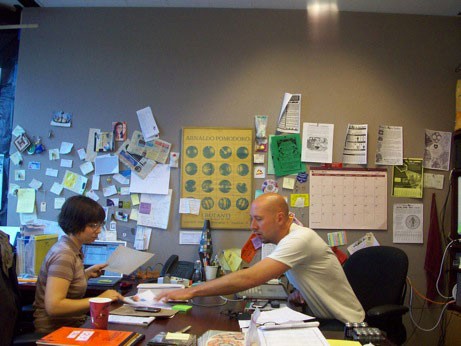
In addition to Hull, another key figure behind the game was Sara Thacher. If Hull was the dreamer behind the project, Thacher was the one who ensured the dream machine ran properly. “We didn’t even think about beta testing before Sara got involved,” said Hull. Thacher has since moved on to the Go Games, but while she was still with Nonchalance, I accompanied her on a biweekly trip she took through Chinatown to make sure the pieces of the game were still intact.
“The story isn’t as important as the experience of doing it,” she said. “Talking about the project isn’t able to be done. You have to experience it.” She removed a large piece of white chalk from her Ziploc bag and drew the Nonchalance symbol (a slightly tilted rabbit head) on the sidewalk. “This is just to help let people know they’re on the right track.”

Thacher’s background made her a perfect fit for the unique project. A graduate of a local “structured art school,” she realized pretty quickly that she wasn’t into the standard, stuffy-museum path that her art degree was taking her. “The actual person-to-person interactions were the art,” she said. She went on to collect a MFA from the California College of the Arts in a new program called Social Practice, designing projects like “Walking a Mile in Other People’s Shoes” (in which Thacher physically walked a mile in someone else’s shoe before shipping it back, along with a personal letter) and “San Francisco Vacation Surrogate” (in which she toured SF for someone who couldn’t, attending events and visiting sites they wanted to see, and shipping them back letters, ticket stubs, postcards and journal entries describing the trip they could have taken). She got mixed up with Nonchalance after answering a Craigslist ad.
The third core member of the group has been Uriah Findley, who Hull knew from his Oaklandish days. Findley’s specialty is audio and video editing but he also designed most of the actual real-world items found in the game. When I first met him, he was carrying an ‘80s-style boombox that was accented with patchy artistic flourishes before spray-painting the entire thing gold.
While Hull was the lead writer of the Game Bible10, it was this core of three — aided by about 30 different freelance writers, artists and actors — who spent much of 2008 creating the project. But even when the pieces were in place, the hardest part was getting people to walk through the doors of 580 California Street. To do that they had to create “in roads,” bait to attract players. The group posted vague, mysterious flyers around San Francisco, started fictional eBay auctions and utilized a variety of sections on Craigslist to spread the word. “People thought it was a cult,” joked Hull. But soon enough, the people came. After that, it was all word of mouth. In early 2010 the group celebrated the 4,000th person to complete Act I.11
A few weeks after our first conversation, I went with Hull on a Nonchalance venture. We sat in his car, drinking coffee, and waited for Act IV in the game to begin.
In the previous few weeks, eight of the game’s most hardcore players had received a variety of postcards, emails and phone calls from game characters. These communications came embedded with seemingly nonsensical clues. Only when all eight players came together would the clues make sense. The day before, they had been sent the final clue instructing them when and where to meet. Hull motioned to a nearby alley, “They’re going to come out of there… at least, I think they’re going to come out of there.”
At this point, there was still plenty that could go wrong. Someone could have misheard a clue. Or they could have taken a left when they should have taken a right. Or someone might not have shown up, leaving the other seven with incomplete clues. Beta testing can solve only so many problems. So we waited in Hull’s car. And we waited. The silence gave him a moment to reflect on the future, and end, of these games.
See, this whole project, while being a public art installation and all of the other slippery identities contained within that, is also a business development project. Hull is marketing Nonchalance as a media production company with creative services, and these games are a calling card of sorts, a tangible product companies can use to decipher how best to use their services. So far, Nonchalance has completed a handful of client projects, including developing an ARG for Greenpeace and creative consulting for the Oakland International Airport. After the game’s conclusion in April, the group will focus on networking and trying to sell the idea that this, whatever this is, has some value to clients. “We’ve had this ‘If you build it, they will come’ attitude,” said Hull. When I asked him what the group plans to do if they can’t generate the business, he responded immediately, almost instinctively: “We have to.” There’s no other option.
Yet as I sat beside Hull, I could sense some uncertainty about the group’s future. What if all the past work had been for nothing? But then Hull’s eyes widened and he sat up in his chair, suddenly giddy, worries about the future wiped out.
“There they are.”
The first eight participants of Act IV emerged from an alleyway, a little behind schedule but still on course. Hull had once told me the grand mission statement of this project, “The Jejune Institute calls itself the Center for Socio-Reengineering, and that’s something that’s a little bit cheeky, but we’re pretty sincere about that goal. We want to reengineer the way people are interacting with space and with media and with each other. That’s our objective.” That mission was now working.
Eight people — strangers to one another before that day — were on a hunt together. They turned to their right, the wrong direction, basically aiming directly to where we were parked. I ducked in my seat. Then after a brief conference, the group changed course, moving left, the correct direction. They crossed the street and entered a labyrinthine mausoleum12 where the rest of the act would take place.
“My job here is done,” said Hull. His role that day was simply to make sure the eight got into the mausoleum, at which point the overseeing duties would be handed over to Thacher and Findley. Hull wanted to stay out of the players’ sight on the remote chance someone might recognize him, ruining the illusion of the game. Yet, instead of heading home, he idled in the parking lot. “I think there’s a spot on the second floor we can look down from.”

He turned off his car and we jogged up to the mausoleum’s second floor.13 “I have to hide from Sara,” he said. “She’d kill me if she knew I was in here.” From our perch we watched the eight perform the duties exactly as assigned. Hull watched raptly from over the railing, a creator beaming down at this new world he’d made.
Scheduled for April 10th, the game’s epilogue event will be a live socio-reengineering seminar, sponsored by the Jejune Institute. Seating is limited to 200 people, with priority given to players who have been through Acts I to IV. For those able to get in, Hull promises a magical experience. “We’re actually scaring ourselves,” he told me. “What we’re attempting right now we could have never conceived of two months ago.”
But after that day, people walking into 580 California Street and asking for Jejune will be greeted with looks of confusion and, possibly, calls for security. The doorway to the Institute’s world will be shuttered and locked, and our own world will be a little less magical because of it.
1 Pronunciation is key: It’s a soft ‘je’ sound on that second ‘j’, rhyming with the final syllable in Gerard Depardieu’s last name.
2 Or, better yet, go to the official website, which explains it much better than I could.
3 Unfortunately, I might add.
4 If you’re still having a hard time grasping this, think of one of those murder mystery weekends. (You’re probably familiar with these less because you actually participated and more because they were one of the go-to plotlines for late ’80s, early ’90s network sitcoms.) And then extend the timeframe in which the game is played. And the environment where it takes place. And the amount of ways you can receive information. And without having to leave a tip.
5 Most ARGs are part of viral marketing campaigns for various movies or TV shows. In 2007, the company 42 Entertainment famously created a series of websites “designed by The Joker” that led fans on a hype-building scavenger hunt through San Diego, the setting of that year’s Comic-Con, which ultimately culminated in unlocking teaser photos and audio clips for The Dark Knight. Almost instantly the photos and clips were uploaded to the Internet, so someone didn’t have to go through the actual game to get that reward, but there’s an argument to be made that going through the scavenger hunt in real-time was the reward in of itself. You know, journey v. destination stuff.
6 A number of these participants joined forces and created a massive Yahoo! group account dubbed “Cloudmakers” as a way to share information with one another. There’s a good psychoanalytical paper to be found in examining the collaborative aspect of these ARGs, but I’ll just settle for the following armchair observations: As of this writing, there’s an 81-page forum post on the website UnFiction.org devoted to the various sections of Nonchalance, helping gamers trade information about where to go and how to complete certain goals. While you’d expect the tone of an Internet forum like this to be more along the lines of “I did it first and here’s me bragging about it and spoiling it for you” the posts are actually gentle, almost-parental, nudges to help gamers who are stuck, always being mindful not to ruin the blissful experience that comes with solving a puzzle on one’s own.
7 Probably unfairly so, seeing as The Beast was created by an entirely different set of designers from A.I., the only narrative crossovers being that both take place in the future and the appearance of Salla, an extremely minor character in the film who was most likely shoe-horned in to connect the two projects.
8 If you can find the YouTube video of the event, or any number of photos from various news organizations, Hull is disguised in a blue hard hat and orange construction vest.
9 Not to mention that it takes place in a variety of locations. While Act I takes place in Chinatown, Act II takes place in SF’s Mission District, the “in road” being a 1-watt radio transmitter located at the top of Upper Dolores Park playing a 45-minute, NPR-sounding show, alerting anyone with the patience to listen as to what tasks they have to complete in the area. This second Act took about 6 hours to complete as opposed to the 2 hours spent on the first Act. (Needless to say, there was a moment that second day, sludging through the sporadic but constant San Franciscan rain and trying to break the codes with my then-girlfriend, that I didn’t think the relationship was going to last through the afternoon. And now that I think about it actually, if I were to look back on things through just the right prism, this could’ve easily been the inciting event for our eventual break-up.)
Act III, meanwhile, takes place in the Coit Tower park section of SF. From what I understand — we left before going through it; like I said, relationship on the rocks — this third act utilizes PDAs in a more straightforward way, allowing players to hold up their iPhones or whatever web-surfing doo-hickeys they have in certain positions around the park to view videos shot from that specific location showing events from the past, kind of like watching through a mini time portal.
Act IV is described a bit later in the piece, but I was mostly sworn to not reveal too many specifics. I will say it’s the first part not to take place in San Francisco proper and is the most “hands-on” section of the game. As such, I had a hard time seeing how the programmers were going to make it “perpetual” like the other parts, but they were certain they’d find a way.
10 The Game Bible being the basic construction and plot points of the actual story. When I asked Hull about his literary influences, he stumbled towards naming McSweeney’s and Kurt Vonnegut before finally settling on Thomas Pynchon’s The Crying of Lot 49 as the main influence. The tilted rabbit head-shaped symbol that accompanies game locations is a direct descendent of the muted post horns of the Tristero in Pynchon’s novel.
11 Hull says there was about a 50% drop-off with each act, meaning that when the group debuted Act IV, about 120 people were ready to participate in it.
12 While I was sworn to secrecy about where this specific action takes place, there are enough clues in this piece for you to find it if you’re looking. So have at it if you’re one of those types.
13 While in the alcoves of the mausoleum, I pointed out to Hull the odd way the ashes are stored there: They’re in books. One person’s remains are stored in a book standing upright, surrounded by that person’s family, also in books. A large Italian family sat on a ledge like an encyclopedia of their lives. “I love that,” Hull said. “Everyone has a story.”
Rick Paulas is a writer living in Los Angeles.
Top photo courtesy of The Jejune Institute.
Hear Julie Klausner And Her Family
You there! Go listen to “How Was Your Week?”, a new podcast from Awl pal Julie Klausner. The first episode “features an interview with authoress/ provacateur[/Awl pal] Natasha Vargas-Cooper, a rundown of the Best Picture nominees from Julie’s parents, an unfavorable review of The King’s Speech, and the debut of a new title for something that we will use, one day: Oscar Madison Won’t Let You Pack Your Bags.” It’s here, or here if you want it from iTunes.
In 'The Adjustment Bureau,' Heaven Looks A Lot Like Corporate Hell
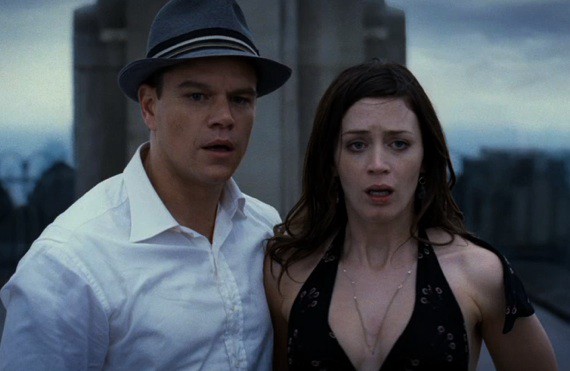
The order of the universe was upended last weekend with the opening of The Adjustment Bureau, a speculative thriller written and directed by George Nolfi which was lauded by the hard-to-please Manohla Dargis in the New York Times, and unequivocally panned by Peter Travers — whose opinion ordinarily runs the gamut between “Brilliant!” and “A Masterpiece!” — in Rolling Stone. (“Sorta heartwarming entertainment,” offered Roger Ebert amiably.) But few appear to have questioned the validity of this movie’s shocking assumptions: first, that God himself is a careerist, and second, that angels are responsible for everything good that has ever happened in history, and are the only thing standing between mankind and total ruin. Evidently we are less trustworthy than a pack of rabid jackals, so why God (known here as “The Chairman”) would keep us around at all is one among many, many half-baked metaphysical questions this movie never bothers to answer.
There are some good things about The Adjustment Bureau. It is very pretty and very expensively made. The best part is that Matt Damon and Emily Blunt have the most appealing on-screen chemistry that has appeared in a big movie in ages. They are sweet, sexy and funny. Anthony Mackie, too, is really wonderful. And everything to do with politics is spectacular, including the flood of clever cameos at the beginning: Terry McAuliffe, Jon Stewart, Madeleine Albright, Matalin and Carville… so many, and each one well done.
But Nolfi’s two-dimensional cosmology is profoundly, horribly depressing, plus it makes very little sense. He turns the whole universe into a yuppie prison of aspirationalism. Even the angels are buffoons in suits who are slaving away at their angel-ing in order to rise to a higher position. “You wait for a case to make your mark as an agent and you find out it’s booby-trapped,” John Slattery moans, for all the world like Roger Stirling when Joan reminds him that she’s married.
So, these angels want better jobs or maybe more prestige; this is not exactly made clear. The really good angel jobs are at this angel HQ that looks like the world’s bleakest and most sumptuous law offices where they represent like kleptocrat third-world dictators, or Monsanto. Unsurprisingly, these high-class superangels do not look as though they’re having any fun at all; they mostly look worried about their billable hours. One gathers they must have better angel apartments and can take longer paid vacations — I swear to The Chairman, the angels discuss vacations at the beginning of this meshuggeneh movie.
Anyway, the central concern of The Adjustment Bureau is that old business of changing one’s fate (a theme beloved of Philip K. Dick whose story is here mutilated). Matt Damon’s David Norris is on a celestially orchestrated track to become President, if only he can keep his mitts off of the irresistible dancer and wag, Elise, whom he runs into in the bathroom and on the bus and things. Fat chance! But here is the gnarly part. The meanest of the superangels, Terence Stamp, explains to Norris that if he doesn’t back off of Elise, the most terrible things will happen. Firstly, Norris won’t become President, as specified by “the plan”! Oh no! and also, Elise herself won’t become a world-famous dancer. Instead she will suffer the HORRIBLE fate of teaching dance to six-year-olds. Nooooooooooooo!
This is where every sane adult in the audience has got to be going Jesus H. Christ what do I have to do to NOT become President, because I would do that instantly even if it involved getting six kinds of leprosy instead of just being boringly un-driven and happy ever after with the most fun and beautiful companion in the world.
“You can make a difference, David,” Stamp continues, idiotically. Oh yeah? Dude has just spent about forever explaining how human beings don’t have free will! How the angels “gave us” the Renaissance and the Enlightenment, because yeah things were so perfect in the 16th and 18th centuries?! (Nobody expects the Spanish Inquisition!) How can David make a difference if he isn’t even in command of his own will? What bloody difference does it make what you do if you’re just being danced around on the puppet-strings of a bunch of vexatious lawyers from the astral plane? Why agree to conform to “the plan”?? Wouldn’t anybody just go all V for Vendetta at this point? Why not, there’s no free will!
This is not a plot hole so much as a massive plotsplosion that leaves behind only a few tiny bits of plot-shrapnel.
It’s somewhat predictable and also sad that a man like Nolfi who spends his days in the Hollywood machine would imagine that all anyone wants is to be famous or “important.” And not only that. The Adjustment Bureau seems to be telling us that an ordinary person would give up anything for fame and position even if he weren’t truly the master of his own fate.
Not everyone believes that there are “important” people who count more than others, or that wealth, fame and power elevate one human being above another in some elemental way. But if you do believe any of that, unless you also believe that you yourself are “important,” you will lose some of your own power; your faith not just in your own agency, but in everyone’s. Which may explain why the Man, who runs Hollywood too, would encourage us to think this way; to believe that teaching six-year-olds how to dance is the worst thing that could ever happen. People with no faith in their own significance, and with no faith in the power of exercising their own free will, are much easier to control.
Maria Bustillos is the author of Dorkismo and Act Like A Gentleman, Think Like A Woman.
